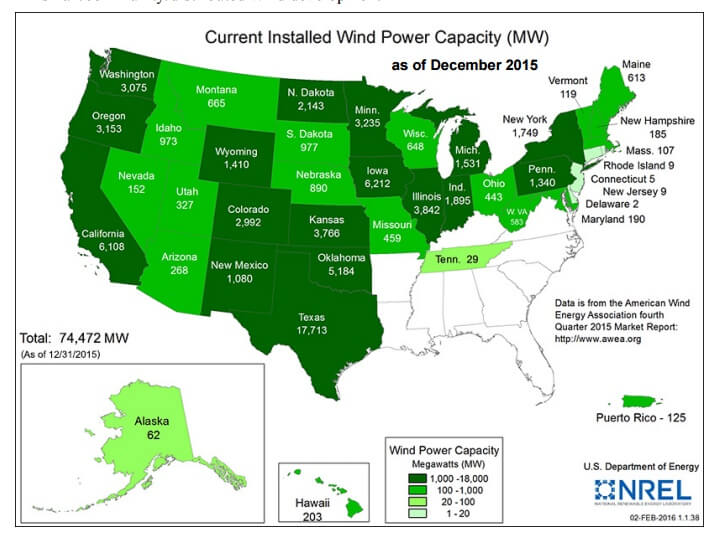Editor’s note: NREL says these reports were written with representatives from the Regional Resource Centers and variety of state contacts, this publication is intended as a companion piece to the Energy Department’s2014 Distributed Wind Market Report, 2014 Wind Technologies Market Report, and 2014 Offshore Wind Market and Economic Analysis.
Established in 2014, the Regional Resource Centers provide regionally focused information to stakeholders, decision-makers and the general public regarding multiple aspects of wind energy, including supply chain, workforce, wind resource, geography, wildlife, electricity infrastructure, and costs. This is the Executive Summary from the report.
Significant expansion of wind energy deployment will be required to achieve the goal of doubling renewable energy production in the United States by 2020. Wind energy currently provides more than 4% of the nation’s electricity but has the potential to provide much more. In 2014, the U.S. Department of Energy (DOE) established six wind Regional Resource Centers (RRCs) to provide information about wind energy, focusing on regional qualities.
The wind industry and DOE are addressing technical challenges to increasing wind energy’s contribution to the national grid (such as reducing turbine costs and increasing energy production and reliability), and they recognize that public acceptance issues can be challenges for wind energy deployment. Wind project development decisions are best made using unbiased information about the benefits and impacts of wind energy.
Well-informed decision-makers and communities are better prepared to navigate the sometimes contentious development process, maximizing the benefits experienced while reducing potentially negative impacts when deploying wind in their regions. Expanding the nation’s wind energy portfolio requires high impact, regionally specific strategies to inform the policy and permitting processes and improve public discourse, thereby reducing conflict around deployment decisions and ultimately increasing the annual rate of wind deployment.
This document summarizes the status and drivers for U.S. wind energy development on regional and state levels. It is intended to be a companion to DOE’s 2014 Distributed Wind Market Report (U.S. DOE 2015a), 2014 Wind Technologies Market Report (U.S. DOE 2015b), and 2014 Offshore Wind Market and Economic Analysis (Navigant 2014) that provide assessments of the national wind markets for each of these technologies.
The RRCs have identified a wide array of market challenges that continue to hinder wider-scale deployments of wind technologies. Highlighted by region in the following sections, these issues include:
- Insufficient transmission capacity and the need for transmission improvements
- Energy market modifications (such as more liquid bilateral markets for integration resources, 15-minute scheduling, and development of regional energy imbalance markets)
- Lack of local wind siting or zoning ordinances; ordinances that do not reflect best practices or do not allow the flexibility in wind development to address small, distributed, community, or utility-scale wind projects
- Integration challenges and costs
- Lack of clear federal policy
- Need for public education and engagement of wind siting issues, exacerbated by misinformation and negative public opinion regarding wind energy
- Poor understanding of wind energy’s economic impacts, including local tax benefits, jobs and economic development, and turbine manufacturing
- State and regional competition
- Challenges with development on federal and native lands
- Need to advance the state-of-the-art in power sector resource planning processes, ensuring that accurate wind information is utilized in utility integrated resource and state-based clean energy planning
- Need for science-based resource planning in siting guidelines, especially for development in sage grouse and other environmentally sensitive areas
- Restricted access to capital; limited financing, funding, and technical assistance for small/community/distributed wind development
- The high costs of offshore wind energy, lack of independent information and outreach geared toward innovative regional procurement targets, attracting financing, alternative financing mechanisms, and regional supply chain development vii This report is available at no cost from the National Renewable Energy Laboratory (NREL) at www.nrel.gov/publications.
- Complexity of the offshore wind regulatory process; addressing technical issues related to installation, interconnection, and operation; researching and mitigating environmental impacts; interacting with other human uses; and public acceptance of offshore wind
- The fact that there are no full-scale offshore wind turbines currently deployed in the United States, leading to an inability to build credibility around the market opportunity.
- For the full report: http://www.nrel.gov/docs/fy16osti/62942.pdf
Filed Under: News, Policy




